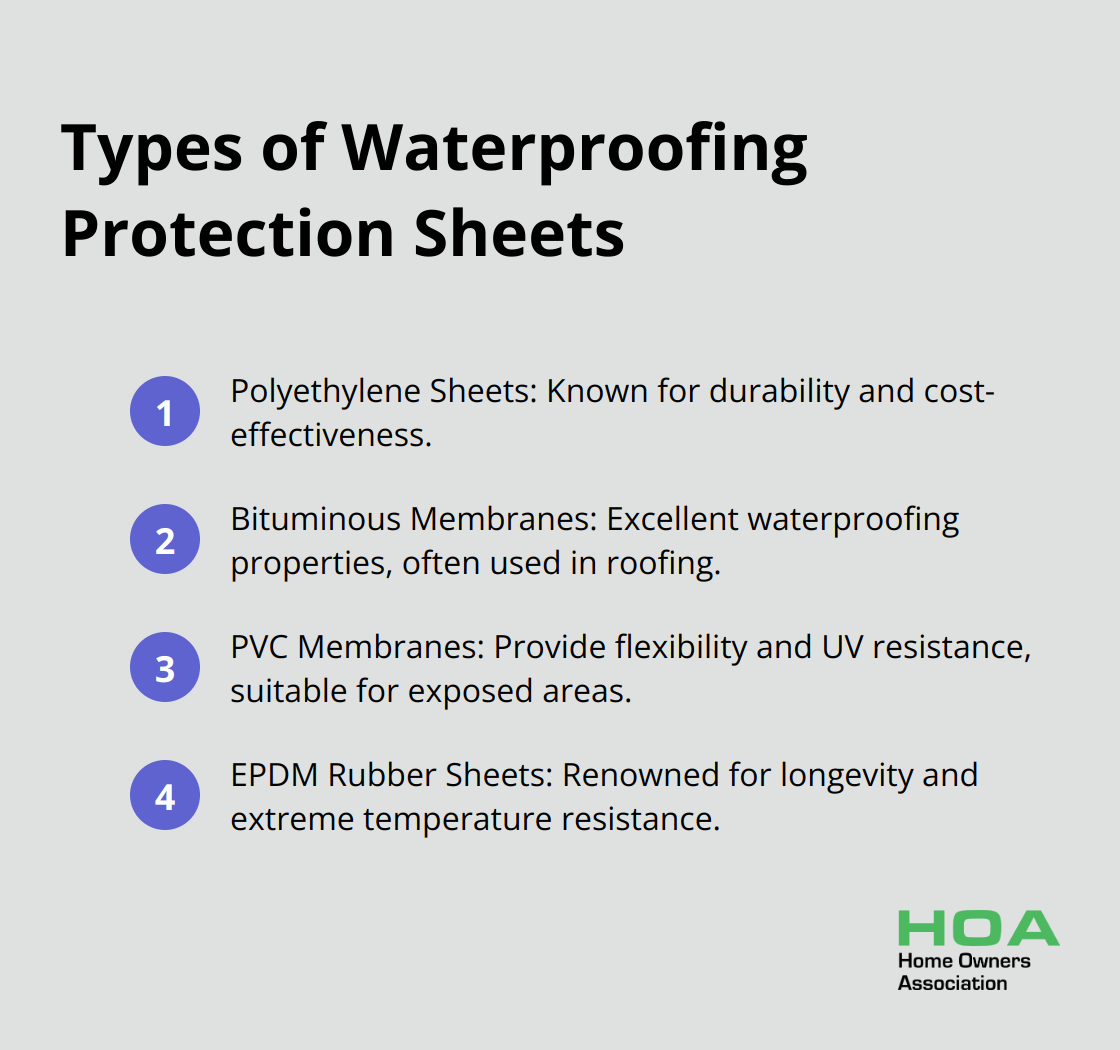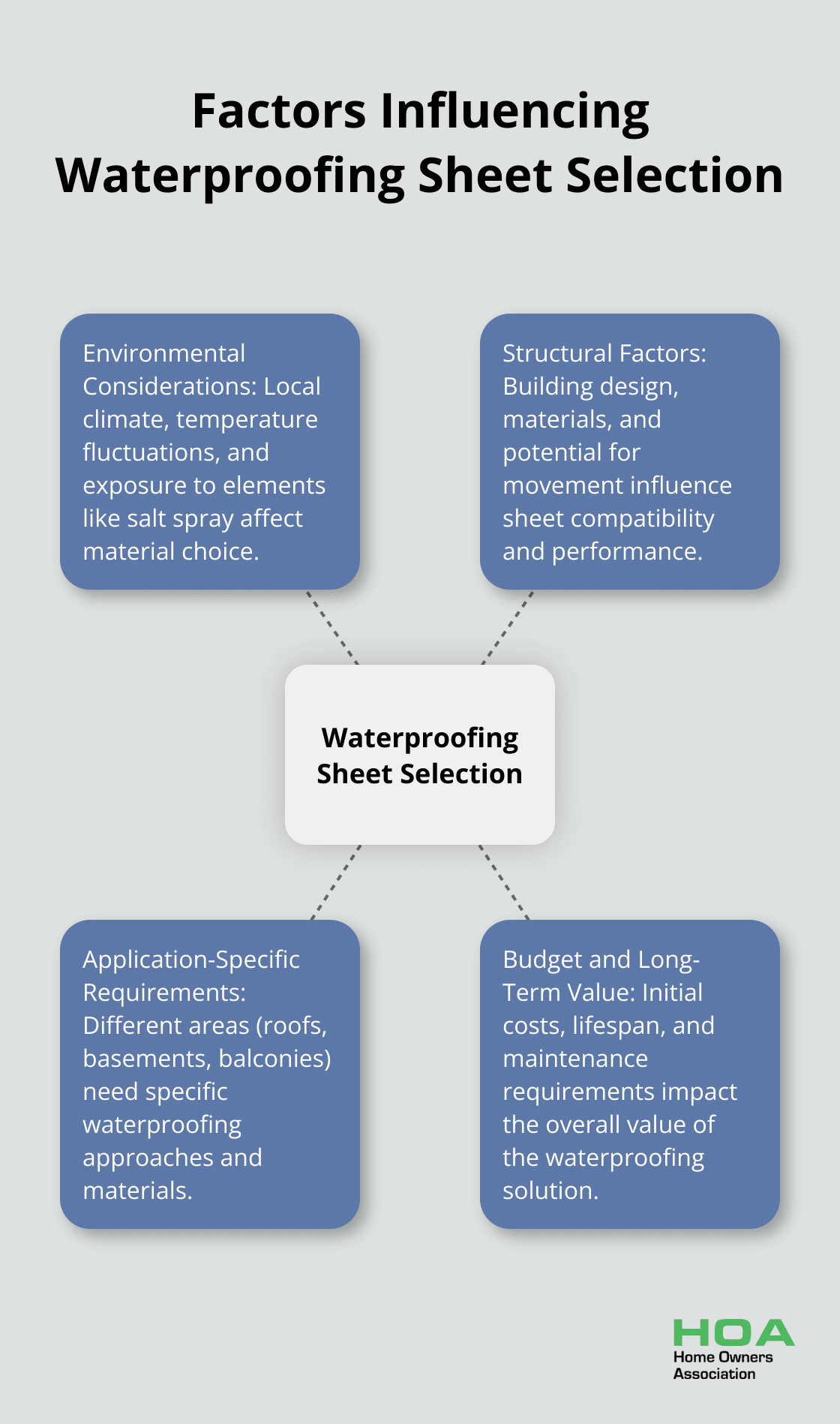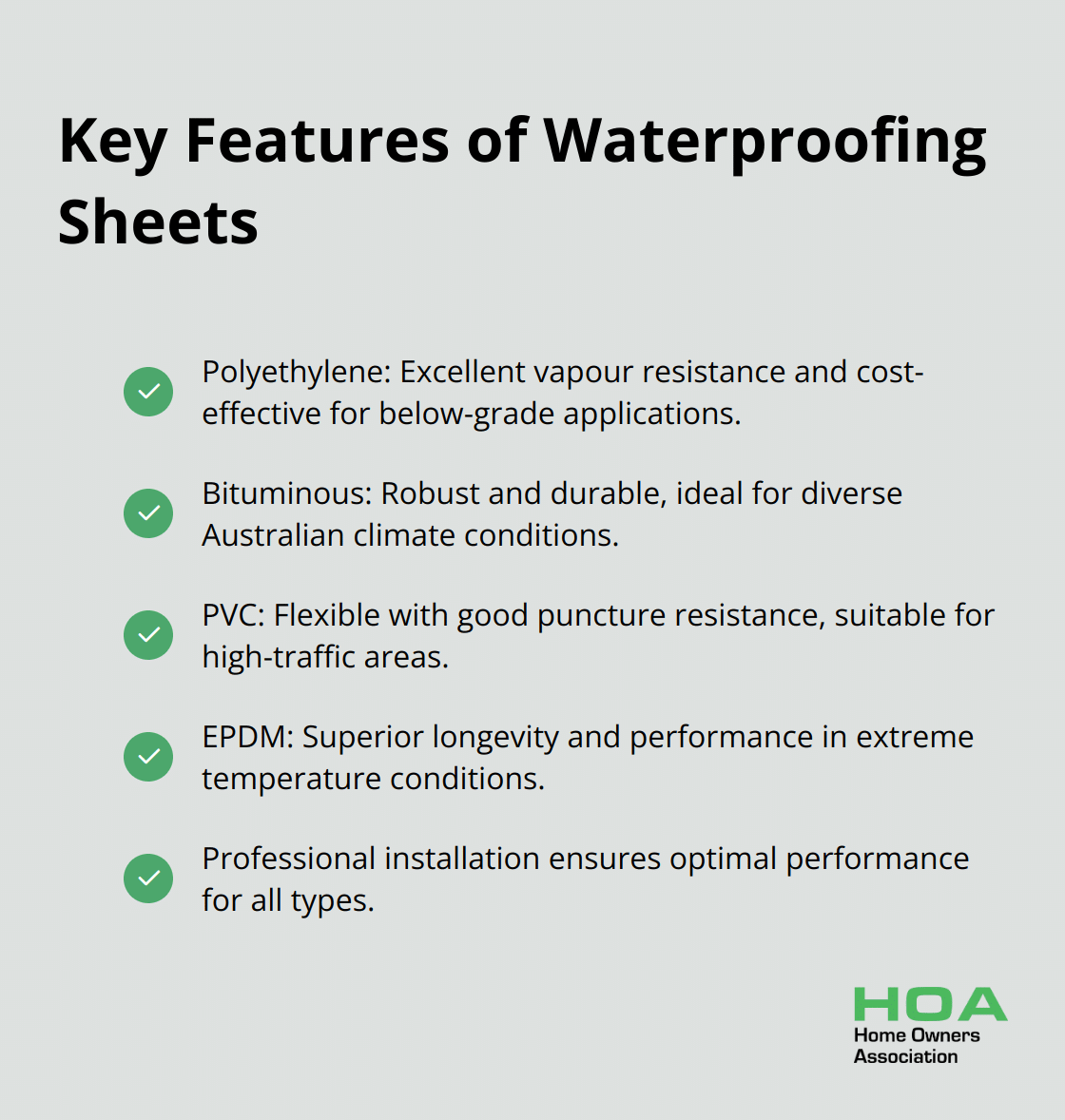
At Home Owners Association, we understand the importance of protecting your property from water damage. Choosing the right waterproofing protection sheet is a critical decision for any homeowner.
This blog post will guide you through the process of selecting the best waterproofing solution for your specific needs. We’ll explore various types of protection sheets, key factors to consider, and top options available in the market.
Understanding Waterproofing Protection Sheets
Definition and Purpose
Vapour and moisture barriers aim to keep moisture (in vapour or liquid form) out of the building envelope. These barriers prevent water damage, which can lead to mould growth, structural decay, and interior deterioration. Their primary function is to create a waterproof seal that safeguards the integrity of structures.
Types of Protection Sheets
The market offers several types of waterproofing protection sheets:

- Polyethylene Sheets: Known for durability and cost-effectiveness.
- Bituminous Membranes: Excellent waterproofing properties, often used in roofing.
- PVC Membranes: Provide flexibility and UV resistance, suitable for exposed areas.
- EPDM Rubber Sheets: Renowned for longevity and extreme temperature resistance.
Key Components and Materials
The effectiveness of protection sheets stems from their composition. High-quality sheets often feature multiple layers:
- Outer Layer: Consists of durable material resistant to environmental factors.
- Inner Layers: Focus on water resistance and substrate adhesion.
A review by the National Roofing Contractors Association found that EPDM roofing systems have gained significant market share and are now the most widely specified synthetic roofing material.
Selection Factors
Choosing the right waterproofing protection sheet requires consideration of various elements:
- Climate: Areas with high rainfall or extreme temperature fluctuations benefit from robust materials like EPDM or PVC.
- Application Area: The specific location (roof, basement, or foundation) influences material choice.
- Building Structure: The design and materials of the building play a role in sheet selection.
Many Australian homeowners prefer bituminous membranes for roofing due to their heat resistance and durability in diverse climate conditions. For below-grade waterproofing, polyethylene sheets often prove more suitable due to their resistance to soil chemicals and ease of installation.
Installation Considerations
Proper installation is paramount for the effectiveness of waterproofing protection sheets. Professional installation ensures:
- Correct application techniques
- Proper sealing of joints and seams
- Adequate surface preparation
The choice of waterproofing protection sheet significantly impacts a building’s long-term health and durability. The next section will explore specific factors to consider when selecting the ideal protection sheet for your property.
Factors Influencing Waterproofing Sheet Selection
Environmental Considerations
The local climate significantly affects the choice of waterproofing sheet. In coastal areas of Australia, where salt spray is common, materials resistant to salt corrosion are essential. Membrane technology for water treatment systems has shown progress, particularly in developing countries.
Regions experiencing extreme temperature fluctuations, such as the outback, benefit from EPDM rubber sheets. The dielectric properties of EPDM remain almost constant in a wide temperature range from -40°C to 120°C.
Structural Factors
The building’s design and materials influence the selection of waterproofing sheet. Concrete structures often pair well with bituminous membranes due to excellent adhesion and compatibility. Timber-framed buildings might require more flexible options like polyethylene sheets to accommodate structural movement.
In multi-storey buildings, the weight of the waterproofing system becomes important. Lighter materials (such as PVC membranes) can reduce the overall load on the structure, potentially saving on structural reinforcement costs.
Application-Specific Requirements
Different areas of a building need specific waterproofing approaches. Roofs require UV-resistant materials. The Australian Building Codes Board recommends materials with a minimum UV resistance of 10 years for exposed applications.
Basements and foundations face unique challenges due to hydrostatic pressure. Sheets with high puncture resistance and the ability to bridge cracks are essential in these areas. Polyethylene sheets (with a thickness of at least 0.5mm) have shown good performance in resisting water pressure up to 70 metres, according to tests conducted by the CSIRO.
Balconies and terraces require materials that can withstand foot traffic and outdoor furniture. Liquid-applied membranes or PVC sheets with a textured surface often provide the best combination of waterproofing and durability for these areas.
Budget and Long-Term Value
The choice of waterproofing sheet impacts a project’s budget and long-term performance. While initial costs matter, considering the lifespan and maintenance requirements often reveals that higher-quality materials offer better value over time.
Bituminous membranes might have a lower upfront cost, but their typical lifespan of 15-20 years means more frequent replacements compared to EPDM sheets, which can last up to 50 years with proper maintenance.
Maintenance costs also vary widely between materials. PVC membranes, for instance, can often be repaired with heat welding, reducing long-term maintenance expenses.
When evaluating waterproofing options, it’s important to consider not just the material cost, but also installation complexity, potential energy savings, and the cost of potential water damage if the system fails.

The next section will explore specific waterproofing protection sheet options, comparing their features, advantages, and potential drawbacks to help you make an informed decision for your property.
Which Waterproofing Sheet Is Best for Your Project?
Polyethylene Sheets: The Versatile Choice
Polyethylene sheets offer versatility and cost-effectiveness, particularly in below-grade applications such as foundations and basements. These sheets provide excellent resistance to water vapour and are relatively easy to install.
However, polyethylene sheets lack UV resistance, making them unsuitable for exposed applications. They also don’t offer the flexibility of some other options, which can be a drawback in structures prone to movement.
Bituminous Membranes: Tough and Durable
Bituminous membranes stand out for their robustness and longevity. Australian roofing applications often favour these membranes due to their excellent heat resistance and durability in diverse climate conditions.
These membranes come in two main types: APP (Atactic Polypropylene) and SBS (Styrene-Butadiene-Styrene). APP membranes suit warmer climates better, while SBS membranes perform better in colder regions.
Bituminous membranes can withstand harsh Australian weather conditions, including extreme heat and UV exposure, when correctly installed. However, they can present more installation challenges than some other options and may require professional application.
PVC and EPDM: Modern Solutions for Complex Needs
PVC (Polyvinyl Chloride) and EPDM (Ethylene Propylene Diene Monomer) membranes represent more modern waterproofing solutions. Both offer excellent flexibility and suit a wide range of applications.
PVC membranes resist punctures and tears well, making them ideal for areas with high foot traffic. They’re also easy to repair, often requiring just heat welding to fix damages.
EPDM rubber sheets excel in extreme temperature conditions. While both these options offer excellent performance, they come at a higher initial cost compared to polyethylene or bituminous membranes. However, their longevity often justifies the investment.
Factors to Consider in Your Selection
When choosing between these options, consider factors like climate, application area, and budget. For exposed areas in harsh climates, EPDM or PVC might be worth the extra cost. For below-grade applications in milder conditions, polyethylene sheets could be the most cost-effective choice.

The best waterproofing solution is one that’s properly installed. Professional installation ensures optimal performance and longevity of your waterproofing system.
Final Thoughts
The selection of a waterproofing protection sheet impacts your property’s long-term health and durability. Climate, application area, building structure, and budget all play a role in determining the best solution for your needs. Professional installation ensures the effectiveness of your chosen waterproofing system, with proper techniques and surface preparation contributing to its performance and longevity.
Investing in the right waterproofing solution protects your property from water damage, prevents mould growth, and maintains structural integrity. This investment can lead to significant cost savings over time by avoiding expensive repairs and increasing your property’s value. Regular maintenance helps identify and address issues before they escalate into significant problems.
Home Owners Association helps Melbourne homeowners make informed decisions about their properties. Our expert advice, trade pricing access, and educational resources guide you through the process of selecting and installing the best waterproofing protection sheet for your specific needs. You safeguard your investment for years to come when you choose the right solution and ensure proper installation.





